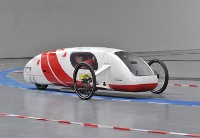
E-Quickie Electric Car Draws Energy from the Ground
At first glance, the E-Quickie looks a lot like a recumbent bike with a driver’s cabin. Some of the less young of us might also feel reminded of the Messerschmidt bubble car. The vehicle was designed and built by 14 students in the Mechatronics and Mechanical Engineering Bachelor’s Programs, as well as those from the international Master’s Program in Mechatronics and Micro-Mechatronic Systems.
The technical highlight of the new car is that it gets its energy from electric conducting paths on the ground. Receivers underneath the car take energy from the tracks through electric induction, directing it onward to the car’s electrical hub drive. “This principle is not really new”, said head of the project, Prof. Jürgen Walter from the faculty of Mechanical Engineering and Mechatronics, and adds “In industry, for example, companies could operate forklifts in this way. However, they’re still far too heavy and slow due to the safety regulations.” With their project work the students wanted to show that such electric vehicles can move quickly and efficiently with modern materials and technological optimization. The students also wanted to prove that the principle of wireless energy transfer is further well suited for application in means of private transportation.
To do so, they designed the individual vehicle components (e.g., steering and braking system, chassis), using high-tech materials. Light weight and aerodynamics were also important factors for designing the outer skin of the vehicle’s body, for which the students chose carbon. Before construction of the vehicle, all its components and finally the whole vehicle were optimized were optimized by computer in a virtual wind channel. One student working group took care of setting up the racing track, which was generously provided by the firm SEW, in Bruchsal. Two other teams were dedicated to the vehicle’s energy absorption and the safety of the entire system.
The entire vehicle weighs 60 kilgrams and the head of the project is positive that its weight can be reduced to 40 kilograms through further optimization. “With other vehicle types you have a weight ratio between driver and vehicle of 1:10/1:15. We’re aiming for a ratio of 1:2 through further development of the E-Quickie.” The team has already achieved success: On May 19-20, the students took part in the Karlsruhe E-Meile, completing 40 laps on the 222-meter conductor track.
“The aim was not only to show how quickly you can move around with the E-Quickie, but most of all how energy efficient the car is”, explains Walter. “We went to the start with half-filled batteries and returned with full ones.” For what then are batteries used for in this system of energy transfer? As soon as the car leaves the electrical conductor tracks, the power supply to the motor is interrupted. “Here the small accumulators then jump on-board the E-Quickie as an energy buffer,” explains Walter, “for example when it’s driven into the garage.”
The E-Quickie already has a good environmental balance. The motor only has a horsepower of 2 KW and still the vehicle reaches a speed of 50 km/h. The batteries serve as a buffer, therefore they are much smaller than by electric cars, from which they draw energy exclusively.
Additional developments are planned for the E-Quickie. A test track at the university campus is also planned to investigate the practicality of the system and to continue optimizing the vehicle for reduced energy use and weight. Further test drives will be held from the HsKA to the nearby castle or from the city center to the Karlsruhe Research Center (Campus KIT North).
The use of the technology for additional applications is already being considered. The wireless energy transmission could also be used to charge mobile telephones without a charger or to organize the underground transport of cargo.